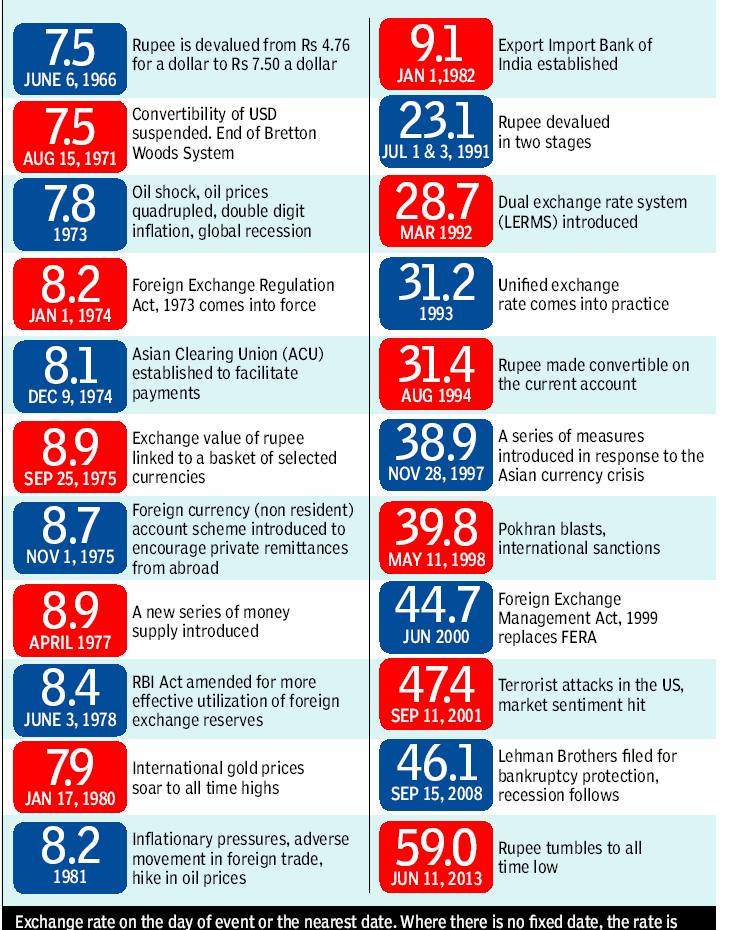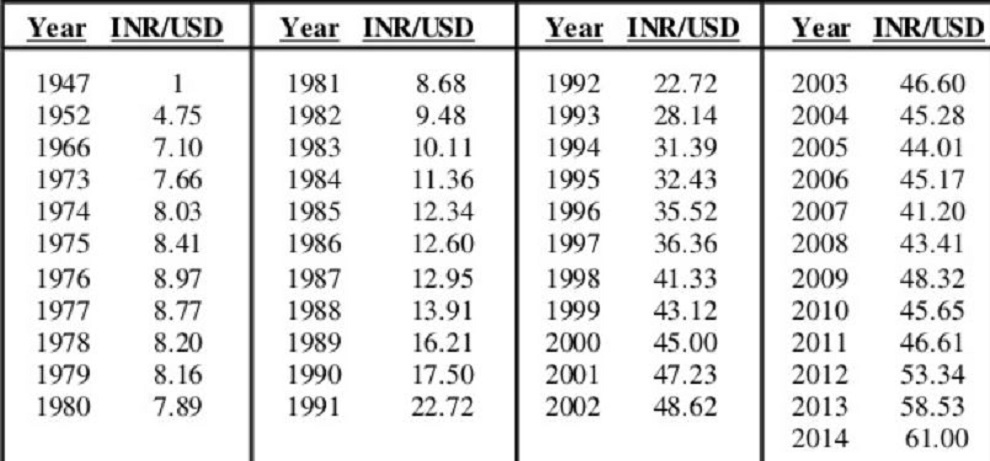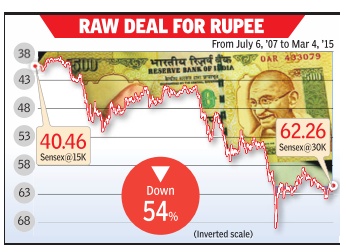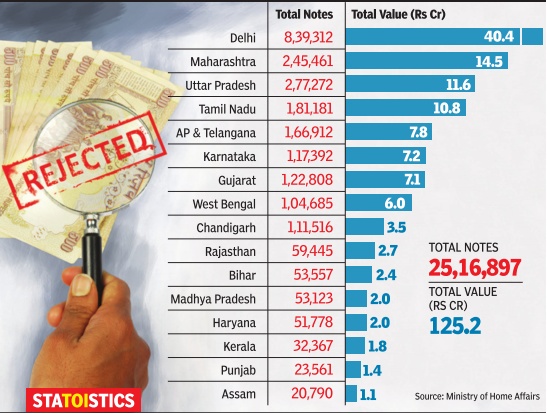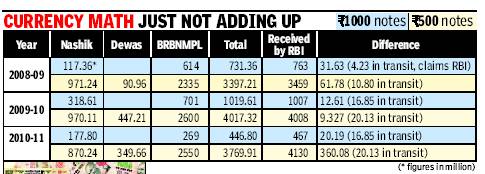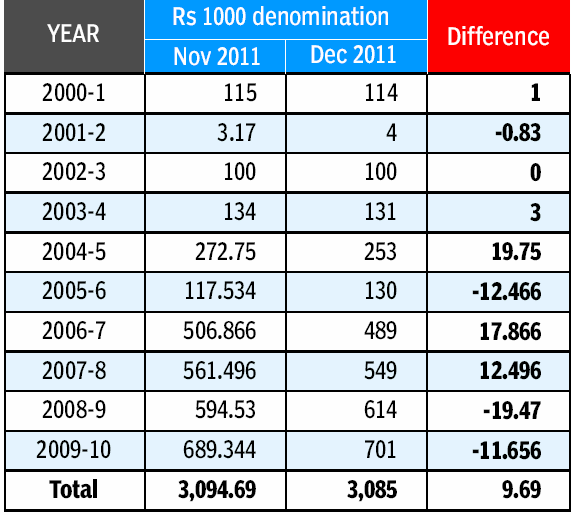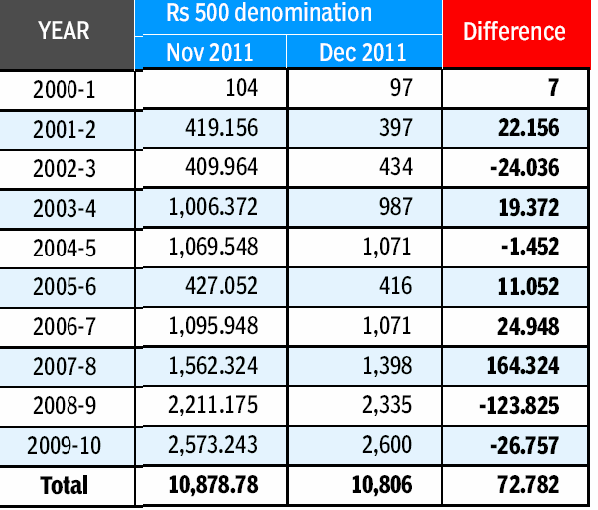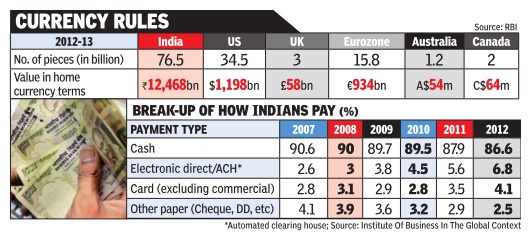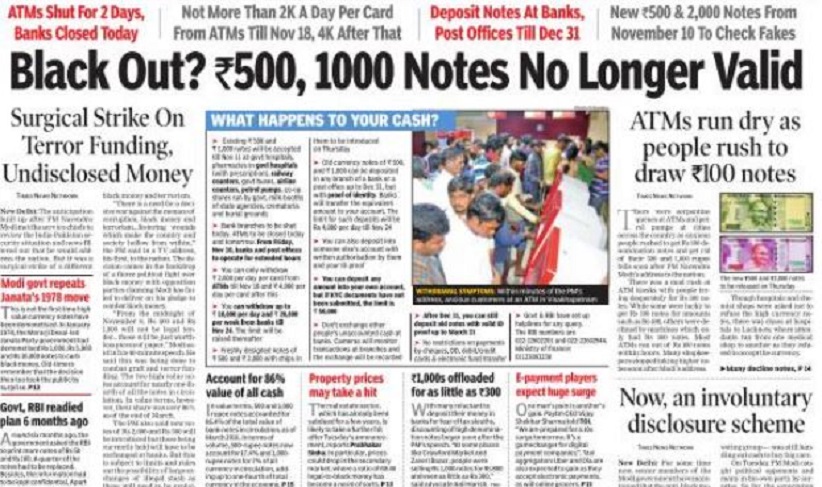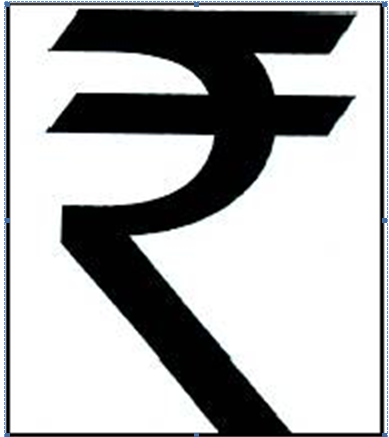Currency: India
This is a collection of articles archived for the excellence of their content. |
Facts about Indian currency
India Today, May 4, 2016
Indian currency is as historic as the Indian civilization. Currency in the form of punch-marked coins existed even before Christ. Coinage can be traced back to as early as the 6th century BC, in the earliest of civilizations in India. This history of coins and notes is as interesting as it is long.
Here are some interesting facts about Indian currency:
1. Currency has existed in the form of coinage in India since the 6th century BC. The Ancient, the medieval and the Mughal period all used currency in the form of coinage. The most notable was Sher Shah Suri's Rupiya, which became the precursor of the modern rupee.
2. Paper money was first issued in the late eighteenth century. Bank of Hindostan, General Bank in Bengal and the Bengal Bank are the first banks to have issued paper currency.
3. Government of India's first set of notes was the Victoria portrait series. For security reasons, the notes of this series were cut in half; one half was sent by post, and upon confirmation of receipt, the other half was sent. They were replaced by the Underprint series in 1867.
4. The Reserve Bank of India was formally inaugurated in 1935 and was empowered to issue Government of India notes. The first note issued by the RBI was a five rupee note bearing King George VI's portrait.
5. The one rupee note was the first banknote printed by independent India.
6. 10,000 rupees is the highest denomination RBI has printed in its history. 1,000 rupees and 10,000 rupees notes were in circulation between 1938 and 1946 but were eventually demonetised.
7. 1,000 rupees, 5,000 rupees and 10,000 rupees notes were reintroduced in 1954 and demonetized in 1978.
8. Denominations of 1 paise, 2 paise, 3 paise, 5 paise, 10 paise, 20 paise and 25 paise were in circulation till June 30, 2011 but were then withdrawn.
9. 50 paise coins are still in circulation. They are called small coins while the other denominations are known as rupee coins.
10. Mahatma Gandhi (MG) series notes introduced in 1996 are being replaced by the MG series 2005 notes with some additional security features. Pre-2005 banknotes could be exchanged at any bank branch till June 30, 2015.
The value of the rupee: fall, fall and occasional rise
1927 to 1966
From 1927 to 1966, Rs. 13 rupees = £1 (pound). Till then the rupee was pegged to the British pound sterling.
In 1966, the rupee was devalued and pegged to the U.S. dollar at a rate of Rs.7.5 = $1.
The steady depreciation of the rupee, 1966-2013
See the accompanying chart
The Times of India 15 June 2013
See Table 1
6/6/66: Devaluation of the rupee
The Times of India, June 7, 2016
June 6, 1966 - or 6/6/66 - turned out to be a defining day in independent India's economic history. It was the day on which Indira Gandhi devalued the rupee by 36.5%, increasing the dollar's value against it by 57.4%. The move sparked bitter, nationwide criticism. In both politics and economics, 1966 was India's annus horribilis. On January 11, Prime Minister Lal Bahadur Shastri - a popular, respected figure - died of a heart attack at Tashkent, and was replaced by Indira. Apparently, the Congress party old guard had conspired to install an inexperienced person, so they could call the shots.
Indira's inheritance in 1966 was onerous. Drought had ravaged foodgrain crops, forcing India to import rice and wheat for the first time. This was easier said than done, for India's foreign exchange reserves were sparse. In 1965, with imports of Rs 2,194 crore and exports of only Rs 1,264 crore, India's trade deficit of Rs 930 crore was the highest during the sixties. With no money to import food, India sought aid from the US' ('friendly foreign government' - is this really necessary), whose 'Food for Peace' programme - authorized by Public Law 480 (PL-480) - allowed poor nations like India to pay the US in their own currency. President Lyndon B Johnson obliged by shipping 16 million tonnes of wheat, and 1 million tonnes of rice to India, and disbursing approximately $1 billion to alleviate her financial strain. Indira Gandhi's decision to accept this "ship-to-mouth" aid was unpopular.
1993-2013: Movements of the rupee
Inflation, trade imbalance sink Re
Mayur Shetty The Times of India Mar 05 2015
Growth Story Buoys Sensex Even As Currency Slips From Crisis To Crisis Historically the rupee has moved in tandem with the sensex. A surge in the equity index usually led to the domestic currency firming up against the dollar as foreign funds that drive up stocks also provide support to the rupee. Yet, despite foreign investment consistently rising, the rupee has sharply depreciated from its opening level of 32 against the dollar in 1993 -the year when it was allowed to float freely in terms of demand and supply . The answer to this behavior lies in India's higher inflation and trade deficit which has resulted in rupee finding a new floor every time there is a major global crisis.Here are some of them: Mexican crisis (August-December 1995): Triggered by risk averseness among global investors after Mexico's currency collapse, the rupee which was at 31.40 against the dollar in July `95 depreciated to 33.96 by end-September 1995 and further to 36.48 by end-January 1996. Although the fall was only five rupees it was sharp in percentage terms.Asian Currency Crisis (August '97-April '98): Much as Indian companies, banks and brokers tried to convince international investors that India was not a part of South East Asia, foreign institutional investors continued to stampede out of the country . The international sanctions after the nuclear tests known as Pokhran II did not help. Te rupee exchange rate which was 35.92 in August `'97 worsened to 42.76 against the dollar in August'98.Dotcom bust and 911 attacks (2000-2001): India saw a surge in technology stocks due to the increased business arising out of Y2K. While the dotcom bust weakened the rupee in 2000, the `risk-off' situation following the 911 attacks in New York sent the rupee into a free fall. It weakened from 43.64 per US dollar during April 2000 to 48.43 on September 17.Lehman Brothers collapse and Global Financial Crisis (2008): The rupee witnessed its longest steady spell in the run up to the global financial crisis and was trading around Rs 48 levels. After the crisis the currency breached the level of Rs.50 per dollar on October 27, 2008. The fall would have been sharper had the RBI not spent $18.7 billion worth dollars to support the rupee.US Sovereign downgrade (August 2011): In August 2011 S&P downgraded the US following a political deadlock which blocked funds to the government. But instead of the dollar weakening it was the rupee which lost as global investors sought refuge in US treasury bills.Grexit & Eurozone crises (2011-12): Portugal, Ireland, Greece and Spain formed the PIGS whose governments found it difficult to meet their debt obligations. Greece came close to defaulting and exiting the European Union. The resultant volatility saw the rupee weaken to 54.24 against the dollar during this period but regained its losses the next year.US Taper Tantrums: In May 2013 chief of US Fed Ben Bernanke said that he was considering tapering back the Fed's $70 billion a month liquidity infusion through buyback of bond and mortgage backed securities. When the US Fed sneezes, world markets catch a cold. The rupee fell the sharpest among emerging economies due to India's gigantic current account deficit. Between May 22, 2013 & August 30, 2013, the currency fell 15.5% against the US Dollar.
Depreciation: 2000-13
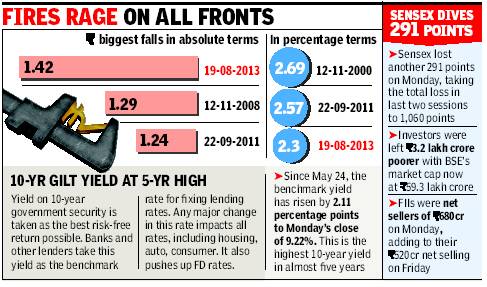
2013: Stabilising the Re through FCNR
The Times of India, Aug 13 2016
Rajan found scheme that rescued Re in 2013 `idiotic'
Outgoing RBI governor Raghuram Rajan said on Friday that he found the $34-billion foreign currency deposit scheme, which staved off a collapse of the rupee in September 2013, to be “completely idiotic“ and “worst of the ideas on the table“ when it was first proposed, but it worked. The RBI's success in taming the runaway rupee in September in 2013 was seen as Rajan's big achievement in his initial months. A special foreign currency non-resident (FCNR-B) deposit scheme, which garnered $34 billion, was seen to have played a crucial role in stabilizing the currency . The scheme was among the first announcements made by Rajan after taking charge.
Speaking during a discussion on former governor D Subbarao's book, `Who Moved My Interest Rate', Rajan said: “I get credit for that idea which I neither invented nor believed in.“
He said that upon joining as an understudy in August, he went around seeking suggestions on what new and interesting measures the RBI could take to change the narrative on the rupee. “There was one proposal which came from bankers that I found completely idiotic. I thought this was a terrible, terrible thing to do. The proposal was: `Give us a 3.5% subsidy and we will bring in money from outside and that will be fantastic',“ said Rajan. According to the governor, he was outraged with a 3.5% subsidy proposal.
2011, 2015: long winning streaks
Mar 25 2015
Re's longest run of gains since 2011
The rupee inched up on 24 March 2015 by 3 paise against the American currency to end at 62.25, extending its winning streak to the seventh straight session -the longest string of gains since June 2011. The rupee opened higher at 62.20 per dollar as against 23 March 2015 closing level of 62.28 per dollar at the Interbank Foreign Exchange (Forex) Market. It then firmed up further to 62.14 per dollar on initial selling of the greenback by banks and exporters in view of sustained capital inflows.
Expectations that the US Federal Reserve will not tighten its monetary policy until the second half of the year has helped emerging market currencies like rupee to gain.
In the Asian market, the euro fell against the dollar and the yen.
2015: One of best performing currencies
The Times of India Jan 01 2016
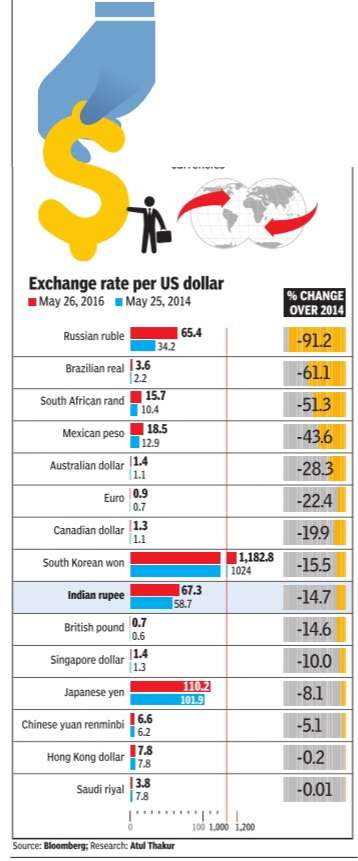
Mayur Shetty
The Indian rupee, despite weakening nearly 5% against the dollar, has emerged as one of the best performing currencies in 2015 as most others have fallen sharply against the dollar. However, early 2016 could end up being volatile for the domestic unit as the dollar surges ahead in the wake of the rate hike by the US Federal Reserve.
The rupee closed at 66.15 at the end of 2015 on Thursday -24 paise stronger than its previous close a day earlier. The dollar has gained Rs 2.79 during the calendar year. Against the greenback, the rupee swung nearly 10% from a high of 61.33 on January 28 to a low of 67.10 on December 14 -which was also a two-year low . But the currency has been strongest among emerging nations.
Among the BRICS nations, only China has been on a par with the rupee with the Chinese yuan weakening by 4.72%. Brazil, Russia and South Africa have depreciated by 49%, 31% and 33% respectively against the greenback. However, early 2016 could end up being volatile for the domestic unit as the dollar surges ahead in the wake of the rate hike by the US Federal Reserve.
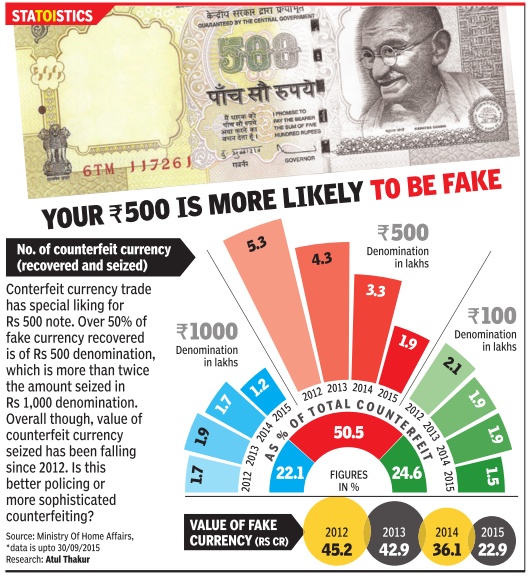
The rupee under various finance ministers
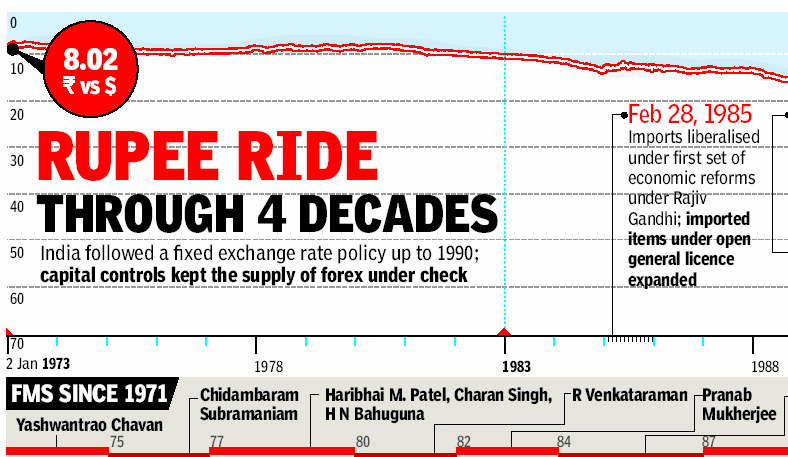
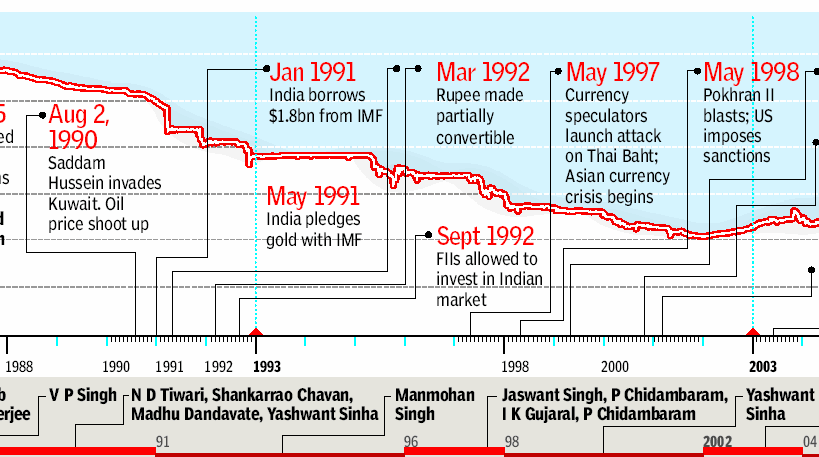
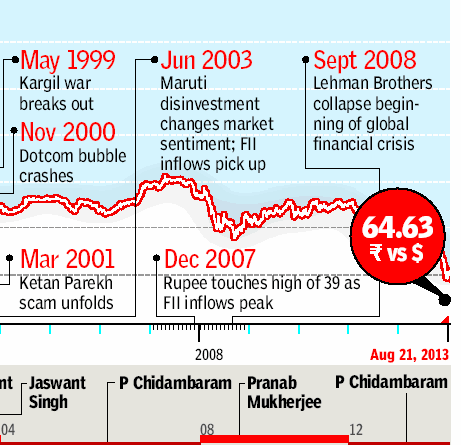
Counterfeiting currency
2012-15: Counterfeit currency
Mar 23 2015
In the past three years, fake currency worth Rs 125 crore has been seized and recovered by the government. According to the answer to a recent Rajya Sabha question, high-quality Indian currency notes printed in Pakistan are being smuggled into the country to create a self-sustaining terror network in south and southeast Asia. In Delhi alone, such currency worth Rs 40.4 crore (the highest in the country) was seized and recovered in the past three years. The national capital was followed by Maharashtra, Uttar Pradesh and Tamil Nadu, each registering recoveries of over Rs 10 crore.

The Times of India
2014: 3rd most counterfeited currency in Switzerland
In Switzerland: Most counterfeited currency after US Dollar and Euro
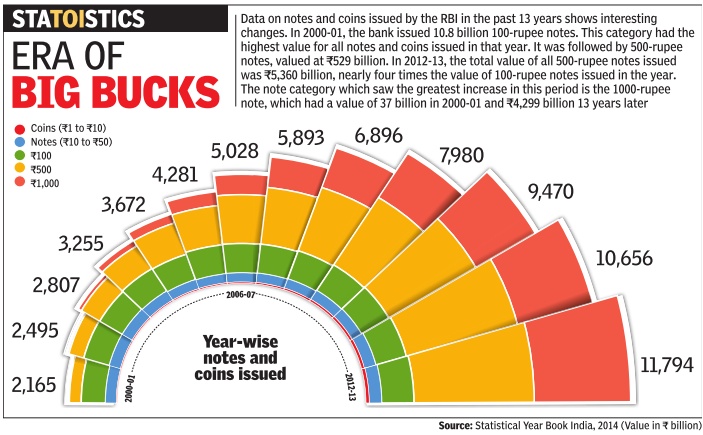
Rupee third on fake foreign currency list in Switzerland
The number of fake Indian rupee notes found in Switzerland during 2013 stood at 403 — the third highest for any foreign currency.
PTI | Jul 20, 2014
NEW DELHI/BERNE: As a debate continues on alleged black money of Indians in Swiss banks, the authorities in Switzerland have come across a significant quantum of fake Indian rupee notes in their country — the third highest for any foreign currency after Euro and the US dollar.
According to the latest counterfeit currency statistics released by Switzerland's Federal Office of Police (Fedpol), the number of fake Euro notes seized in the year 2013 stood at 2,394, while there were 1,101 fake US dollar bills.
The number of fake Indian rupee notes found in Switzerland during 2013 stood at 403 — the third highest for any foreign currency. This included 380 fake Rs 500 notes and another 23 counterfeit Rs 1,000 notes.
However, the numbers have declined considerably since 2012 when Fedpol found as many as 2,624 fake rupee notes — the second highest among foreign currencies after 5,284 counterfeit US dollar notes at that time. The number of fake Euro notes was third highest during that year at 2,084.
The number of fake Swiss franc notes stood at 4,309 during 2012, but was higher than any foreign currency in 2013 at 3,729, as per details compiled by the Fedpol's Counterfeit Currency Unit.
Among other counterfeit foreign currencies found during 2013, there were 99 fake British pound notes, 71 South African rand notes, 34 Deutsche Mark notes (German currency officially in circulation from 1948 till 2002 when Euro was introduced), 23 Chinese yuan notes and ten Canadian dollar.
The number of any other fake foreign currency notes was in single-digits.
Unaccounted for rupees in circulation
Millions of notes not printed in mints land in RBI vaults
Bank, Press Records Don’t Tally
Hemali Chhapia TNN
The Times of India 2013/08/04
Mumbai: Millions of currency notes worth hundreds of crores of rupees that have apparently never been printed at our nation’s mints have mysteriously made it to the vaults of the Reserve Bank of India over the years.
A series of RTI applications reveal that while the mismatch between currency bills printed and those transported to the RBI is seen across denominations, it is more pronounced in the case of higher value notes — those of Rs 1,000 and Rs 500.
Take the Rs 1,000 notes. The redesigned bill was introduced in October 2000. Ever since, the two authorized mints — Bharatiya Reserve Bank Note Mudran Private Limited, Bangalore, and Currency Note Press, Nashik — have printed a total of 4,452.3 million bills. But RBI records show that it has received 4,462 million notes, an excess of 9.7 million notes. That means the RBI has received Rs 970 crore more than what was actually printed.
WHAT THE RBI SPOKESPERSON SAYS
You have collected the data of printing from the press and the supply received from RBI. You cannot do that because there are a lot of logistics involved. Numbers must be compared from the one source; either you take RBI numbers or the printing presses’ numbers. You cannot mix and match.
An aggregate discrepancy of Rs 4,608 crore
In 2006-07 the number of 1000-rupee notes received by the RBI was 589 million. (The number of such notes printed that year was 591m.)
While this closes the difference between what was printed and what was received to a considerable extent, there still remains a discrepancy of about Rs 72 crore for the period in question, which the bank has attributed to “rounding off”.
However, there is a large discrepancy between the numbers provided by the Bharatiya Reserve Bank Note Mudran, RBI’s wholly owned subsidiary, in its response to two similar queries just a month and a half apart under the Right to Information Act. A response dated November 10, 2011 to a query indicates the total count of Rs 500 notes printed between 2000-01 and 2009-10 as 10,878m while another response dated December 24, 2011 shows 10,806 m notes were printed—a difference of 72.782m notes valued at over Rs 3,639 crore (see Tables 3a-c).
Similarly, there is a difference in the case of currency notes of Rs 1000 denomination. The November response indicates the total number of Rs 1000 notes printed between 2000-01 and 2009-2010 as 3094.69m while the December response places it at 3,085m—a difference of 9.69m notes valued at Rs 969 crore (see Tables 3a-c).
The aggregate discrepancy—Rs 500 and Rs 1,000 notes—between the two RTI responses is a significant Rs 4,608 crore.
2016: Fake notes with face value of Rs 400 crore in circulation
The Times of India, May 11 2016
Neeraj Chauhan 250 In Every 10 Lakh Bills Counterfeit: Indian Statistical Institute
Fake notes with face value of Rs 400 crore in circulation
As many as 250 of every 10 lakh notes in circulation in India are fake, and banknotes with a face value of Rs 400 crore are in circulation in the country at any given point of time. The first ever study of counterfeit money has unearthed that fake Indian currency notes (FICN) with a face value of Rs 70 crore are infused into the Indian market every year, with agencies only able to intercept one third of them.
These shocking revelations are part of the study on “Estimation of the quantum of FICN in circulation“, conducted by the Indian Statistical Institute (ISI) Kolkata, which has asked the government to take “immediate steps“, since these figures are only indicative of the extent of the menace.
The findings have been accepted by the government and a series of strong measures to counter this `economic terrorism' is being planned in consultation with the primary FICN detection and probe agency, National Investigation Agency, besides other security and intelligence agencies including CBI, IB, DRI, R&AW and sta te police departments.
The study has further revealed that the detection rate of fake 100 and 500 rupee notes were found to be about the same and higher than the detection rate of 1000 rupee notes by about 10%. It added that fake 1,000 rupee notes constitute about 50% of the total value of FICN.
The ISI study was based on volumes of FICN detected and cash transaction in the banking sector. The study said that “the detection of FICN is carried out primarily by commercial banks. However, their reporting is irregular too and only three banks Axis, HDFC and ICICI report about 80% of the detection“. ISI, however, concluded that “the existing systems of seizure and detection are enough to flush out the quantum of FICN being infused“. The institute says that if detection can be improved, the value of FICN in circulation can be reduced by at least 20% annually .
As per the NIA probe, which has a Terror Funding and Fake Currency Cell, Pakistan is the major supplier of FICN in India. “In 2015 alone, some 9-10 cases have come to the notice where FICN has come by sea or air from Pakistan,“ said NIA inspector general Alok Mittal. Link title
Cash-to-GDP ratio
2012-13: 12%
Jan 19 2015
India's love for cash costs $3.5bn a yr
Cash-to-GDP ratio higher than peers, but e-payments double in 5 yrs: Study
The Reserve Bank of India and commercial banks annually spend around Rs 21,000 crore ($3.5 billion) in currency operations costs while citizens of Delhi alone spend Rs 9.1 crore and 60 lakh hours in collecting cash. The scale of this burden is unique to India considering that it is among the most cash-intensive economies in the world with a cash-to-GDP ratio of 12%, almost four times as much as other markets such as Brazil (3.93%), Mexico (5.3%) and South Africa (3.73%).
There are many reasons why India has to pay such a high price for its payments.One is the need to frequently reissue notes due to poor handling -low-value notes have to be replaced in less than a year. The other reason is the need to frequently upgrade security features and replace old notes. There is a huge cost in pulling old notes out of circulation and replacing them. India also has unique issues in logistics and in some places the cur rency notes have to be transported by helicopter.
A report on `Cost of Cash in India' commissioned by MasterCard and brought out by the Institute For Business In The Global Context has highlighted how much of a drag the overdependence on currency for payment is turning out to be. One reason for the increased dependence on cash is the lack of access to banking with a third of the population over 15 years not having used a bank account.
The report also highlights that although mobile banking has picked up, it is not yet being used for payments. There has been a jump in electronic payments since 2007 with its share increasing from 2.6% to 6.8%.This is largely due to the development of non-cash payment systems such as the Real Time Gross Settlement (RTGS), National Electronic Funds Transfer (NEFT) and National Electronic Clearing System (NECS). But the report says that growth in these segments has typically benefited the commercial sector more than retail clients. The value of transactions through ATMs has grown sixfold from Rs 3 lakh crore in 2007 to about Rs 18 lakh crore in 2012, according to the report. However, when the ATM transactions are weighted for population, India continues to fare poorly even when compared to lesser developed markets such as Kenya, Niger or Egypt. According to RBI data, in 2013, 15,400 crore banknotes were issued globally, of which the maximum banknotes, 5,400 crore, were issued by China and almost 2,000 crore by India. The glob al projections for the next three years have been worked out at 16,000 crore, 16,600 crore and 17,300 crore banknotes, for the world, China and India, respectively .
“The steps taken by RBI over the years strive to make the idea of financial inclusion a reality . Innovations in the electronic payments space not only deliver greater transparency but more importantly , they simplify transactions, enhance security , increase efficiency and have the potential to dramatically reduce costs,“ said Vikas Varma, area head, south Asia, MasterCard.
The report also busts the conventional wisdom which assumes that cash is free. Citing the example of Delhi, the report says that residents spend 60 lakh hours and Rs 9.1 crore ($1.5 million) to obtain cash. Compared to this, Hyderabad, which is smaller, spends 17 lakh hours and Rs 3.2 crore ($0.5 million) to do the same, which corresponds to fees and transport costs about twice as high as Delhi on a per capita basis.
Cost of printing Indian currency
2016
Sivakumar B, At 78p per print, Rs 1 note now profitable, Nov 06 2016 : The Times of India
Two different mints charge the Reserve Bank of India different amounts to print the same currency denominations. This was revealed in replies to an RTI plea filed by RTI activist Subhash Agarwal.
While Bharatiya Reserve Bank Note Mudran Pvt Ltd, an RBI-owned company , prints Rs 10 and Rs 20 notes at a cost of 70 and 95 paise, respectively , the same notes printed by the governmentowned Security Printing and Minting Corporation of India (SPMCIL) cost Rs 1.22 and Rs 1.216, respectively.
The cost of printing Re 1 notes at the SPMCIL has come down from Rs 1.14 per unit to 78.5 paise due to better use of technology . The printing of one-ru pee notes, which was discontinued in 1994 because of high printing cost, is now costing less, the RBI has revealed. The currency is printed by the SPMCIL.
The cost of printing Re 1 notes in 1994-95 was Rs 1.48 a note and when reintroduced, the cost came down to Rs 1.14 and now it has reduced below its nomination value to 78.5 paise.
Demonetisation
1978
Surprise & panic: History repeats itself 38 yrs later, Nov 09 2016 : The Times of India
2016 was not the first time high value currency notes were demonetised.
In January 1978, the Morarji Desai-led Janata Party government had demonitised Rs 1,000, Rs 5,000 and Rs 10,000 notes to curb black money .This was less than a year after the Emergency was lifted.
Old-timers remember that the decision then too had taken the public by surprise, leading to panic and a rush to banks although people were given time to exchange old notes.
To put things in perspective, a Rs 1,000 note in 1978 could buy 5 sq ft of real estate space in south Mumbai. In 2016, a Rs 500 note would not even be worth 100th of a square foot.
Senior advocate Anil Harish said people with unaccounted money were reluctant to deposit their high denomination currency in banks because of fear of income tax sleuths. “At places like Crawford Market and Zaveri Bazar, people were selling Rs 1,000 notes for as little as Rs 300,“ he said.
At banks, people were asked to fill in a form when they came to exchange old notes.The banks would inform the I-T cell if people walked in with unusually large amounts. “If they were unable to explain the source of income, the I-T wing would levy the prevalent tax, which was as high as 90% in those days,“ he added.
Said advocate Nishith Desai, “I remember 1978, when people had to go with bags full of cash to the bank. It is an excellent step, but the idea is old.“
A senior chartered accountant with Kalyaniwala & Mistry said, “If you want to flush out black money , it is a good step. In 1978 there was no great disruption, however, since the notes were not with common people. Then they had demonetised Rs 1,000 notes which had a huge monetary value. The 500 and 1,000 rupee notes do not have the same value today; even the average man on the street will have these notes.“
2016
Black Out? Rs 500, 1000 Notes No Longer Valid, Nov 09 2016 : The Times of India
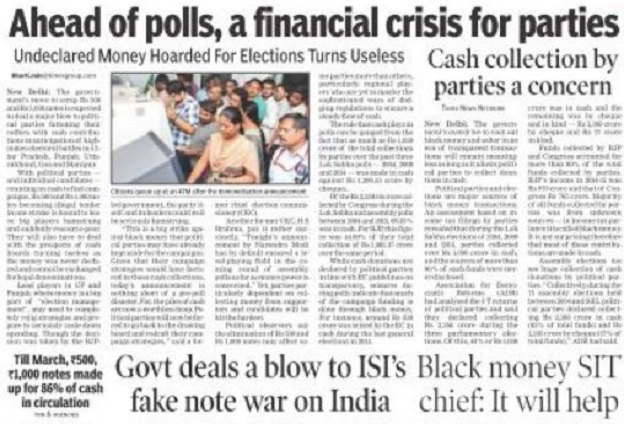
i) thwart Pakistan’s attempts to subvert the Indian rupee (by printing counterfeit Indian currency of high denominations like Rs. 500 and Rs.1,000), and
ii)render useless the illegal cash that political parties had collected and stowed away.

The Times of India
ATMs Shut For 2 Days, Banks Closed Today
Not More Than 2K A Day Per Card From ATMs Till Nov 18, 4K After That
Deposit Notes At Banks, Post Offices Till Dec 31
New Rs 500 & 2,000 Notes From November 10 To Check Fakes
Surgical Strike On Terror Funding, Undisclosed Money
The anticipation built up after PM Narendra Modi met the service chiefs to review the India-Pakistan security situation and news filtered out that he would address the nation. But it was a surgical strike of a different kind, with Modi delivering a stunning surprise by scrapping Rs 1,000 and Rs 500 notes and calling for a “decisive war“ against corruption, black money and terrorism.
“There is a need for a decisive war against the menace of corruption, black money and terrorism...festering wounds which make the country and society hollow from within,“ the PM said in a TV address, his first, to the nation. The decision comes in the backdrop of a fierce political fight over black money with opposition parties claiming Modi has failed to deliver on his pledge to combat black money .
“From the midnight of November 8, Rs 500 and Rs 1,000 will not be legal tender...these will be just worthless pieces of paper,“ Modi said in his 40-minute speech. He said this was being done to combat graft and terror funding. The two high-value notes account for nearly one-fourth of all the notes in circulation. In value terms, however, their share was over 86% as of the end of March.
The PM also said new notes of Rs 2,000 and Rs 500 will be introduced but those being currently held will have to be exchanged at banks. But this is subject to limits and rules out the possibility of large exchanges of illegal stash as these will need to be explained and accounted for. Pitching the decision as a much needed antidote to stamp out the menace of corruption and terror funding, the PM said “Black money and corruption are the biggest obstacles in eradicating poverty...Have you ever thought how these terrorists get their money? Enemies from across the border have run their operations using fake currency notes.“
Describing illegal finan cial activities as the “biggest blot“, Modi said that despite several steps taken by his government over the last twoand-a-half years, India's global ranking on corruption had moved only to 76th position from 100th earlier.
According to the finance ministry , the total number of bank notes in circulation rose by 40% between 2011 and 2016, while the increase in number of notes of Rs 500 denomination was 76% and for Rs 1,000 denomination was 109%.
The World Bank in July 2010 estimated the size of In dia's shadow economy at 20.7% of GDP in 1999, rising to 23.2% in 2007. “A parallel shadow economy corrodes and eats into the vitals of the country's economy ,“ a finance ministry statement said. BLACK OUT? P 2, 13, 14, 15, 25, 29 & 30 It (a parallel shadow econo my) generates inflation, which adversely affects the poor and the middle classes more than others. It deprives government of its legitimate revenues which could have been otherwise used for welfare and development activities,“ a finance ministry statement said.
The move could have political ramifications in the forthcoming state elections as it impacts the capacity of parties to spend unaccounted cash for campaigning and various political payments.
As per Tuesday's announcement, ATM withdrawals will be restricted to Rs 2,000 per day and withdrawals from bank accounts will be limited to Rs 10,000 a day and Rs 20,000 a week. Banks will remain closed on Wednesday and ATMs will also not function for the next two days, Modi said.
Apart from depositing money in bank accounts, Rs 500 and Rs 1,000 notes can also be changed for lower denomination currency notes at designated banks and post offices on production of valid government identity cards like PAN, Aadhaar and election card from November 10 to November 24 with a daily limit of Rs 4,000.
The demonetised currency notes will remain valid for transactions like booking of air tickets, railway and government bus journeys and hospitals till midnight of November 11 and 12. The RBI and the finance ministry have set up helplines to answer questions.
Six months’ preparation
RBI got 6 months to prepare for this, Nov 09 2016 : The Times of India
Around six months ago [around May 2016], the government asked the RBI to prepare for its latest assault on black money , and told the currency manager to print more Rs 50 and Rs 100 notes, with PM Modi having decided to phase out the current lot of Rs 500 and Rs 1,000 notes earlier this year.
After all the task was hu mongous: replacing 23 billion notes.Besides, the information had to be kept confidential at all costs.
In any case, apart from the PM, only finance minister Arun Jaitley knew, and two senior officers each in the finance ministry and the RBI were in the loop.
The six months were used not just to print enough Rs 50 and Rs 100 currency notes, but also to plan the operations meticulously . This meant that, on Tuesday 8 Nov 2016, the Reserve Bank of India initiated the first “public“ move when its board met around 6pm and recommended the withdrawal of Rs 500 and Rs 1,000 notes. Soon, the government, which was ready with the notification, moved the Cabinet, which met at 6.30pm on Tuesday . The decision was taken and the PM went on air to announce the first demonetisation in 38 years.
The government's calculation was simple. It sees major gains accruing to the economy , beginning with an immediate halt to black money transac tions -at least in the near run. This is ex pected to force peo ple to use only legal channels, which will result in higher tax es in the govern ment's kitty .
While those showing “agricultu ral income“ can still use a possible loop transact in cash, the hole to transact in cash, the window is seen to be limited and the government expects bulk of the funds to flow into the banking system. This itself is going to provide more boost for lending, which has remained subdued, a senior government official said. “We have hastened the printing of these notes,“ RBI governor Urjit Patel said.
Denominations in circulation
See graphic
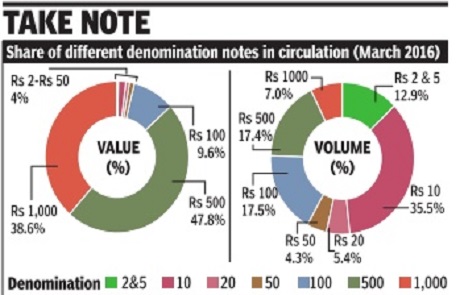
The Times of India
In March 2016
The decision to phase out Rs 500 and Rs 1,000 notes is linked to concerns over the increasing proportion of high-denomination currency in use.
Economic affairs secretary Shaktikanta Das said on Tuesday that, between 2011 and 2016, the circulation of all notes grew by 40%, but that of Rs 500 and Rs 1,000 notes grew by 76% and 109%, respectively . Between 2011 and 2016 the economy expanded by 30%, he added to emphasise the spurt in the Rs 500, Rs 1,000 bills' circulation.
In value terms, Rs 500 and Rs 1,000 notes accounted for 86.4% of the total value of bank notes in circulation, as of March 2016. Despite the emphasis and shift towards non-cash modes of transaction, the Indian economy remains flush with high value notes. In terms of volume, Rs 500 notes now account for 17.4%, and Rs 1,000 notes for 7% of the total notes in circulation.
Rupee symbol
Rupee becomes only 5th currency to get a symbol Design By IIT Grad Cleared By Cabinet
New Delhi: In keeping with India’s growing economic might and its status as a major investment destination, the hitherto humble rupee is all set to get a distinct identity in the form of a new symbol. The Union Cabinet on Thursday gave its approval to the symbol which combines the Roman letter ‘R’ with the Devnagri ‘Ra’.
The symbol will catapult the rupee into the company of four ‘elite’ currencies which have similarly distinct identities — the US dollar, euro, yen and British pound.
The symbol has been designed by D Udaya Kumar, an IIT Bombay post-graduate, who has just joined as a teacher at IIT Guwahati. Kumar will receive a prize money of Rs 2.5 lakh for his efforts. The symbol will standardize the expression for the Indian rupee in different languages, both within and outside the country.
‘‘It’s a big statement on the Indian currency. It would distinguish the rupee from those countries whose currencies are also designated as rupee or rupiah, such as Pakistan, Nepal, Sri Lanka and Indonesia,’’ I&B minister Ambika Soni said after the Cabinet meeting. The symbol, she added, would reflect the strength and robustness of the Indian economy.
Till now, the Indian currency was simply denoted by Rs or INR. Kumar’s symbol was chosen after a public competition was held among resident Indian citizens inviting entries for a symbol which ‘‘reflects and captures the Indian ethos and culture’’.
Over 3,000 entries were received. These were evaluated by a jury headed by the RBI deputy governor, which included experts from reputed art and design institutes.
‘‘The entries were presented to the jury in such a manner that the identity of the competitors was not revealed to the jury members. The jury selected five final entries and also gave its evaluation of these five entries to the government to take a final decision,’’ said Soni. Re symbol to be adopted in 6 mths New Delhi: The new symbol for the rupee, cleared by Cabinet on Thursday, will not be printed or embossed on currency notes or coins, but it would be included in the ‘Unicode Standard’ and major scripts of the world to ensure that it is easily displayed and printed in the electronic and print media.
Unicode is an international standard that allows text data to be interchanged globally without conflict. After incorporation in the global and Indian codes, the symbol will be used by all individuals and entities within and outside the country.
The symbol will be adopted in a span of six months in the country, and within 18 to 24 months globally, Soni said, adding that it will feature on computer keyboards and software for worldwide use.
‘‘It is a perfect blend of Indian and Roman letters — capital ‘R’ and Devanagri ‘Ra’ which represents rupaiah — to appeal to international and Indian audiences. My design is based on the tricolour, with two lines at the top and white space in between,’’ Kumar told a news agency.
After encoding of the symbol in the Unicode Standard and National Standard, NASSCOM will approach software development companies for incorporating the rupee symbol in their operative software, as a new programme or as an update, to enable computer users worldwide to use the symbol even if it is not embedded on the keyboards (much like the way Euro symbol is used even though it is not embedded in the keyboards in use in India).
MAKING A MARK
The new symbol blends the Devnagri ‘Ra’ and Roman ‘R’. Its design is based on the tricolour, says creator D Udaya Kumar
Re. 1 notes
Dec 27 2014
One rupee notes are set to make a comeback after two decades, although in a different colour.
Instead of the familiar indigo, the new Re 1 notes will be predominantly pink-green on the front and back in combination with others, a finance ministry notification said.Unlike other currency notes, the Re 1 notes will be issued by the government. As was the norm earlier, the Re 1 note will be signed by the finance secretary, while the Reserve Bank of India governor will continue to sign notes of all other denominations.
“It contains the words `Bharat Sarkar' above the words `Government of India' with the year 2015 on the representation of the Re 1 coin with the rupee symbol having floral design and the surrounding design has a picture of `Sagar Samrat', the oil exploration platform and with the authentic rendering of value in fifteen Indian languages in the language panel with the year's figure on the centre bottom in international number,“ the notification said. Other currency notes have RBI printed on them.
Over the last few years, the government and the RBI have focused on coins for smaller denominations and discontinued Re 1 and Rs 2 notes citing the high cost involved and the clogging of presses. But the decision to go back to Re 1 notes came as a surprise.
See also
Sensex <> The stock market: India <> Mutual Funds: India <> Rupee: India <> Gold in the Indian economy
